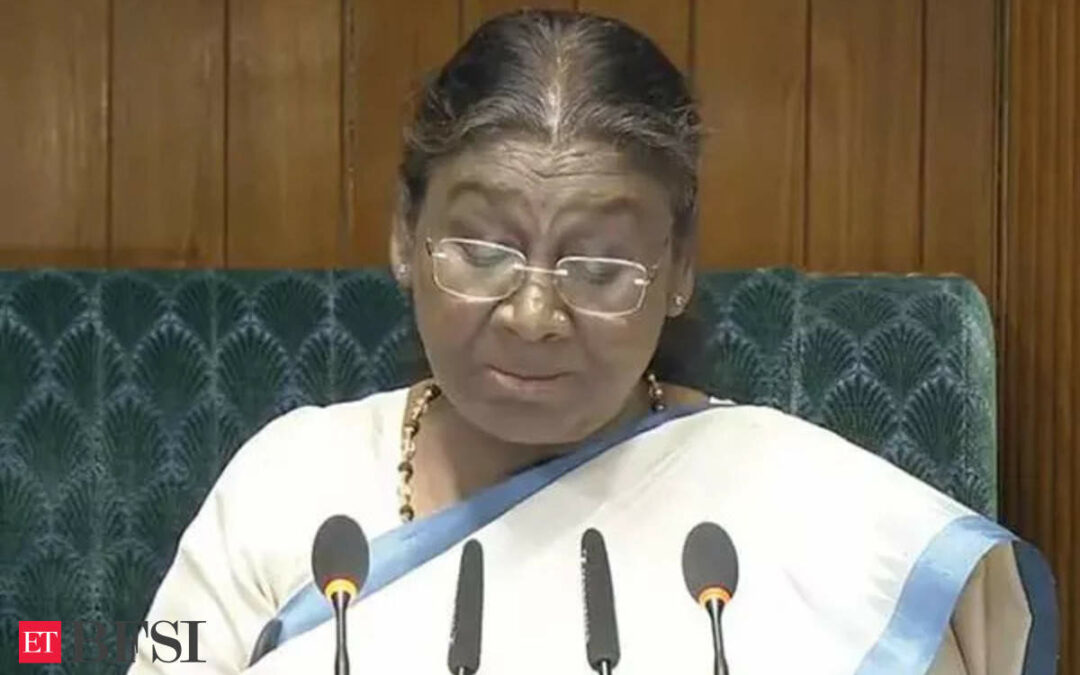New Delhi, The first budget of the newly-formed NDA government next month will take “many historic steps” as well as accelerate the pace of economic reforms and lay a roadmap for ‘far-reaching policies’ and ‘futuristic vision’ of the government to make India the world’s third largest economy, President Droupadi Murmu said on Thursday. In her first address to the joint sitting of Parliament since the constitution of the 18th Lok Sabha, she outlined the economic vision of the NDA government as well as highlighted achievements in the past decade under Prime Minister Narendra Modi.
A stable government with clear majority is “a mandate that the work of making India a developed nation continues uninterrupted and India attains its goals”, she said.
The new government under Modi is to present a full Budget for the fiscal year 2024-25 (April 2024 to March 2025) next month which is likely to lay down priorities in matters of taxation and policy as well as reform agenda for the near term.
“This budget will be an effective document of the government’s far-reaching policies and futuristic vision,” she said.
“Along with major economic and social decisions, many historic steps will also be seen in this budget,” she said without elaborating.
“The pace of reforms will be further accelerated in tune with the aspirations of people of India for rapid development,” she said.
With the National Democratic Alliance (NDA) retaining power for a third consecutive term, analysts are expecting broad policy continuity, with the government continuing to prioritise infrastructure capex, improvements to the business environment, and gradual fiscal consolidation.
The President said the resolve to ‘reform, perform and transform’ has made India the fastest growing economy in the world and the nation has risen to become the 5th largest economy from being the 11th ranked economy.
From 2021 to 2024, India has grown at an average rate of 8 per cent annually.
“India has achieved this growth amidst the global pandemic and despite ongoing conflicts in different parts of the world. This has been made possible due to reforms and major decisions undertaken in the national interest in the last 10 years,” she said, adding India alone is contributing 15 per cent of the global growth.
Now, the government is striving to make India the 3rd largest economy in the world, she said. “Achieving this goal will also strengthen the foundation of a developed India.”
“During the phase of unstable governments in the country that lasted several decades, many governments, even if willing, were neither able to bring reforms nor take critical decisions. The people of India have now changed this situation by their decisive mandate.
“Many such reforms have taken place in the last 10 years, which are greatly benefiting the nation today. Even when these reforms were being taken up, they were opposed and attempts were made to spread negativity. But all these reforms have stood the test of time,” she said.
Highlighting the reforms, she said to save India’s banking sector from collapsing, the government brought banking reforms and made laws like Insolvency and Bankruptcy Code which have made the country’s banking sector one of the strongest banking sectors in the world.
“Our public sector banks are robust and profitable today. Profits of public sector banks have crossed Rs 1.4 lakh crore in 2023-24, which is 35 per cent higher than last year. The strength of our banks enables them to expand their credit base and contribute to the economic development of the nation. The NPAs of public sector banks are also continuously decreasing,” she said.
While SBI is earning record profits and LIC is stronger than ever, GST collections for the first time ever crossed Rs 2 lakh crore in April.
Giving sneak purview to priorities of the government, Murmu said the government is giving equal importance to all the three pillars of the economy — manufacturing, services and agriculture.
Production-linked incentive (PLI) schemes and ease of doing business have contributed to increasing investments and employment opportunities on a large scale.
“Along with the traditional sectors, sunrise sectors are also being promoted in mission mode. Be it semiconductor or solar, be it electric vehicles or electronic goods, be it green hydrogen or batteries, be it aircraft carriers or fighter Jets, India is expanding in all these sectors,” she said.
The government is also making continuous efforts to reduce the cost of logistics. It is also strengthening the services sector.
Simultaneously, investments in green industries are being increased, leading to an increase in ‘green jobs’.
Stating that India is emerging as a leader in every sector from IT to tourism and from health to wellness, she said this this is creating a large number of new opportunities for employment and self-employment.
The President said in the last 10 years, the government has placed great emphasis on every aspect of the rural economy. Agro-based industries, dairy and fishery-based industries are being expanded in villages. Cooperatives have been accorded priority.
“A major problem of small farmers is related to storage. Therefore, my government has commenced work on a scheme to create the world’s largest storage capacity in the cooperative sector,” she said.
Under PM-Kisan Samman Nidhi, more than Rs 3,20,000 crore have been disbursed to farmers.
Policies, she said, were focused on making India more self-reliant and increasing farmers’ income through increased exports.
The President said the government believes that there should be healthy competition among the states to attract investors from all over the world.
“This is the true spirit of competitive cooperative federalism,” she said. “We will continue to move ahead with the belief that the development of the country lies in the development of the states.”
Outlining the policy push in the last decade, Murmu said focus on infrastructure development has seen construction of more than 3,80,000 kilometres of village roads under the PM Gram Sadak Yojana while also expanding the network of National Highways and Expressways in the country.
“The pace of construction of National Highways has more than doubled,” she said.
While work on the High-Speed Rail Ecosystem between Ahmedabad and Mumbai (popularly known as Bullet Train) is also progressing at a rapid pace, the government has decided to conduct feasibility studies for bullet train corridors in the north, south and east of the country, she said, adding work on inland waterways has started on such a large scale.










